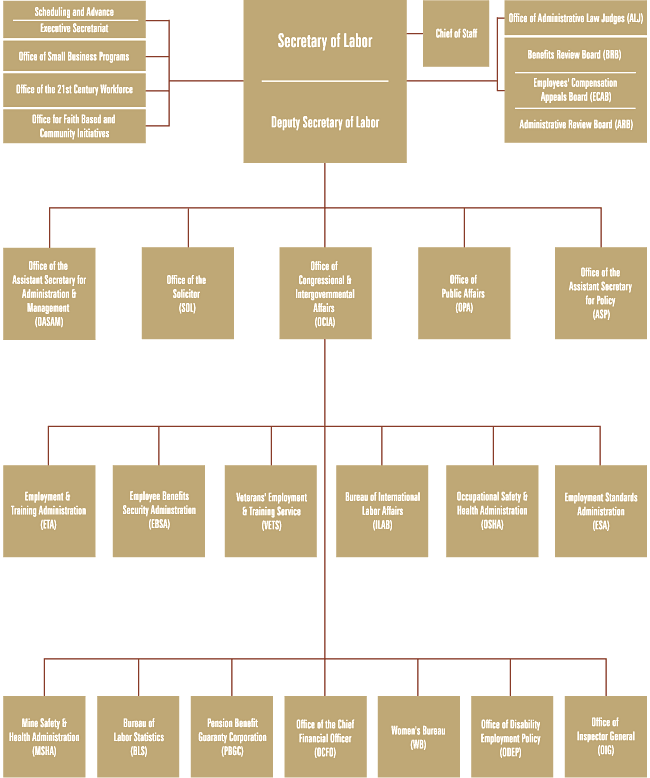|
DOL Annual Report, Fiscal Year 2003
Appendix 1
Department of Labor Organization

image mapped version
Agency Missions
Bureau of International Labor Affairs (ILAB): To carry out the Secretary's international responsibilities, develop Departmental policy and programs relating to international labor activities, and coordinate Departmental international activities involving other U.S. Government agencies, intergovernmental organizations, and non-governmental organizations.
Bureau of Labor Statistics (BLS): To produce, analyze, and disseminate essential and accurate statistical data in the field of labor economics to the American public, the U.S. Congress, other federal agencies, State and local governments, business, and labor.
Employee Benefits Security Administration (EBSA): To protect the retirement, health, and other benefits of over 150 million participants and beneficiaries in private sector employee benefit plans.
Employment Standards Administration (ESA): To protect the welfare and rights of, and generate equal employment opportunity for, American workers by promoting compliance with the various laws that it administers; and to provide the best possible program for income replacement, medical treatment, and rehabilitation for injured federal workers, longshore workers, energy workers, and coal miners.
Employment and Training Administration (ETA): To contribute to the more efficient functioning of the U.S. labor market by providing high quality job training, employment, labor market information, and income maintenance services primarily through State and local workforce development systems.
Mine Safety and Health Administration (MSHA): To protect the safety and health of the Nation's miners by determining compliance with federal safety and health standards through inspections and investigations and working cooperatively with the mining industry, labor, and the States to improve training programs aimed at preventing accidents and occupationally caused diseases.
Occupational Safety and Health Administration (OSHA): To assure so far as possible every working man and woman in the Nation safe and healthful working conditions. This includes such strategies as rulemaking, enforcement, compliance assistance, outreach, and partnerships to enable employers to maintain safe and healthful workplaces.
Office of the Assistant Secretary for Administration and Management (OASAM): The Office of the Assistant Secretary for Administration and Management is responsible for the development and promulgation of policies, standards, procedures, systems, and materials related to the resource and administrative management of the Department and for the execution of such policies and directives at Headquarters and in the field. The ASAM also serves as Chief Information Officer and in that capacity provides leadership and assistance to Departmental agencies in all aspects of using information technology to manage programs.
Office of the Chief Financial Officer (OCFO): To oversee all financial management activities relating to the Department's programs and operations, ensure compliance with financial management laws and standards, and develop and manage high-integrity financial information, policies, services, and products in support of the department's mission to prepare and protect American workers.
Office of Disability Employment Policy (ODEP): To provide leadership to increase employment opportunities for adults and youth with disabilities on both the supply and demand sides of the labor market, by expanding access to training, education, employment supports, assistive technology, integrated employment, entrepreneurial development, and small-business opportunities; and by building partnerships with employers and State and local agencies to increase awareness of the benefits of hiring people with disabilities, and to facilitate the use of effective strategies related to employment of people with disabilities.
Office of Inspector General (OIG): To serve the American worker and taxpayer by conducting audits, investigations, and evaluations that result in improvements in the effectiveness, efficiency, and economy of Departmental programs and operations; prevent fraud and abuse in DOL programs and labor racketeering in the American workplace; and provide advice to the Secretary and the Congress on how to attain the highest possible program performance.
Office of the Solicitor (SOL): To ensure that the Nation's labor laws are forcefully and fairly applied in implementing the priority enforcement initiatives of and defending the actions taken by the Department; and to advise agency officials on legal matters, including the development of regulations, standards, and legislation.
Pension Benefit Guaranty Corporation (PBGC): To protect retirement-plan participants' pension benefits and support a healthy retirement plan system by encouraging the continuation and maintenance of private pension plans; protecting pension benefits in ongoing plans; providing timely payments of benefits in the case of terminated pension plans; and making the maximum use of resources and maintaining premiums and operating costs at the lowest levels consistent with statutory responsibilities. PBGC is an independent Federal corporation.
Veterans' Employment and Training Service (VETS): To help Veterans, Reservists, and National Guard members in securing and maintaining employment and the rights and benefits associated with employment.
Women's Bureau (WB): To promote profitable employment opportunities for women, to empower them by enhancing their skills and improving their working conditions, and to provide employers with more alternatives to meet their labor needs.
|



